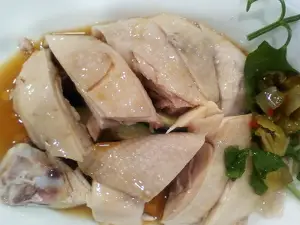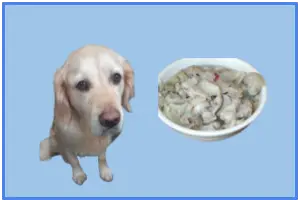
One of the creatures that has been examined and researched the most is the chicken.
The fun fact about them is that they are the most common bird, with a population of 25 BILLION, and exceed humans by a ratio of more than 3 to 1.
Imagine if they all chose to attack at once! Quite terrifying!
It’s no secret that the primary source of protein in the diets of Westerners is chicken.
Chicken is a fantastic addition to most meals in order to have a well-rounded diet because it is low in fat, high in protein, widely available, and simple to cook.
But can you give chicken to your dog every day? Yes, you can give dogs chicken every day, but it is not sufficient. For a balanced diet that promotes health, dogs also require the vitamins and minerals found in fruits and vegetables.
How much boiled chicken should you feed your dog?
All dogs love boiled chicken, and you must have witnessed your friend quickly consume the entire meal! We feed boiled chicken more frequently because of the dogs’ obsession with it and because of the food’s nutritious value.
The quantity of cooked chicken you should give your dog each day will vary depending on his age, weight, and general health.
In general, you can provide a dog with an optimal weight of 19–20 lbs. 1/3 to 1/4 cups of cooked chicken.
In other words, you can feed 1/3 cup of cooked chicken for every 20 lbs of your dog’s body weight. If your dog weighs less or more, this formula may still be useful. Instead of dividing up the chicken into portions because there is already less of it, you can feed it all at once each day. You have a choice!
For unwell dogs, the quantity of cooked chicken may also be increased or decreased.
Can puppies eat (boiled) chicken?
Yes. Giving your puppy cooked chicken is perfectly acceptable because many commercial pet food manufacturers do it. It is a lean protein source that is beneficial.
To ensure that your new puppy receives all the necessary nutrients for good growth, be sure to also provide them a food that is described as “complete and balanced.”
Consult your neighborhood vet for more information and suggestions on the diet of your new dog.
What are the advantages of feeding boiled chicken to dogs?
Although some dogs may have a reaction to chicken, including it in your dog’s diet has several advantages.
As a significant source of protein, chicken offers crucial amino acids that help keep and sustain your dog’s healthy muscles as they age. The Omega 6 fatty acids, which are also abundant in chicken, give your dog the energy they need for long walks and ball chases as well as aid in the better absorption of vitamins and nutrients, the management of inflammation, the promotion of healthy growth and development, and the maintenance of healthy skin and hair.
Remember to support your bones! Chicken’s glucosamine content makes for stronger, more durable bones, which can help avoid arthritis.
Can I feed my dog boiled chicken everyday?
You can give chicken to your dog every day. Make sure the chicken is cooked thoroughly and in a moderate amount. Dogs can be fed chicken along with other nutritious foods like whole grains and vegetables. Chicken is a fantastic source of protein and nutrients for dogs.
Additionally, it’s a good idea to check that the chicken your dog is eating has been cooked through before serving it to them.
Despite being a fantastic source of protein if you want to occasionally treat your dog with chicken, we advise mixing it with other meats like:
Beef: being high in protein, iron, zinc, selenium, and vitamins B12, B3, and B6, beef is typically one of the more economical meats and is generally nutritious for dogs.
Red meat is often rich in fat. However, unlike in humans, red meat is not known to promote canine arteriosclerosis, and there are many beef sources that are leaner and lower in fat.
Here is the nutritional data for 3.5 ounces (100 grams) of broiled, 10% fat ground beef:
- Calories: 217
- Water: 61%
- Protein: 26.1 grams
- Carbs: 0 grams
- Sugar: 0 grams
- Fiber: 0 grams
- Fat: 11.8 grams
Pork: although less frequently used in pet food, pork is a good source of protein, B vitamins, iron, selenium, zinc, and phosphorus. It is one of the fattier meats, though, so older or less energetic dogs could find it less acceptable. Make sure your pork is ethically obtained. Pigs are extremely susceptible to stress and suffer from a condition known as PSS (porcine stress syndrome), which can cause serious adverse alterations to the flesh.
The following nutrients are present in 3.5 ounces (100 grams) of cooked, ground pork:
- Calories: 297
- Water: 53%
- Protein: 25.7 grams
- Carbs: 0 grams
- Sugar: 0 grams
- Fiber: 0 grams
- Fat: 20.8 grams
Chicken: there are numerous different chicken cuts, including drumsticks, thighs, wings, and breasts. Each cut has a unique caloric content and protein to fat ratio.
One of the most popular chicken cuts is the chicken breast. It has a lot of protein and little fat
The following nutritional information applies to one 172-gram serving of skinless, boneless, cooked chicken breast:
- Calories: 284
- Protein: 53.4 grams
- Carbs: 0 grams
- Fat: 6.2 grams
What is the correct way to boil chicken for your dog?
Here are the following steps on how to boil chicken for your dog the correct way.
Step 1: Put the chicken (boneless breast and thighs) in a pot filled with water.
Step 2: Cover the saucepan so the water can come to a boil.
Step 3: Bring the chicken to a boil for 12 to 15 minutes, or until thoroughly cooked.
Step 4: Shred cooked chicken after allowing it to cool.
Step 5: Serve a small portion to your dog and store the remainder for them if they are unable to eat it within 72 hours.
What are the dangers of feeding raw chicken to dogs?
There aren’t many dangers to a dog’s life from chicken meat. Dogs can become harmed by chicken primarily as a result of their owners’ negligence.
Here are a few dangers associated with feeding chicken meat to dogs.
Choking hazards
The dog could suffocate if you don’t remove the chicken meat from the bones.
Small fragments of bones can be left in the chicken meat, despite the fact that dogs are aware of what bones are and cannot consume them. If the dog ingests them together with the meat, it could result in choking or digestive problems.
Additionally, the dog can use its teeth to break the delicate bones from boiling chicken into smaller pieces.
Allergic reactions
Even while chicken may be nutritious for dogs and is a favorite among many, some dogs may be allergic to it and suffer more negative effects than positive ones.
Skin infections, diarrhea, and coughing are just a few examples of allergic reactions. Therefore, it may be detrimental to serve chicken to your allergic dog.
Salmonella infection
Only consuming raw meat can result in a dog contracting salmonella. Make sure the chicken is thoroughly cooked before feeding it to the dog, because eating raw meat has also been linked to other bacterial diseases.
What is the best cut of chicken to boil for your dog?
All parts of the chicken are healthy for dogs, but the ideal parts to feed them are the wings or thighs if you feed them raw chicken. If you cook the chicken, choose bits that don’t have any bones, such as the chicken breast. Furthermore, it is well known that when a dog is recovering, nothing is better than chicken rice.
When it comes to price of the chicken parts drumsticks were by far the cheapest when we cooked bone-in chicken breasts, thighs, drumsticks, and wings before removing the meat from the bones to calculate the cost per edible ounce. The most expensive item was wings, which was unexpected. They are also tasty, juicy, and simple to prepare.
Should I feed rice with boiled chicken?
The answer is yes. As long as the chicken isn’t cooked in oil, chicken and rice may be a fantastic, healthful meal for dogs.
In contrast to many other recipes, this diet is also simple to swallow without upsetting a dog’s stomach. This is seen by many dog owners as a good alternative to packaged kibble.
Chicken is simple to digest and rich in the vitamins, minerals, and amino acids your dog needs to heal. Chicken and rice can be calming and just what dogs with diarrhea need to help them make better stools.
Conclusion: how much boiled chicken can I feed my dog?
A smart strategy to cut calories and give your dog highly bioavailable and necessary nutrients is to give him chicken every day.
To prevent many health issues in dogs, preparing your own chicken breast or avoiding inexpensive dog diets containing by-products may be a smart place to start.
Feeding your dog chicken every day is a safe and wholesome choice as long as you prepare it properly.
Photo credits
¹ Photo by adalidda dot com on Flickr





